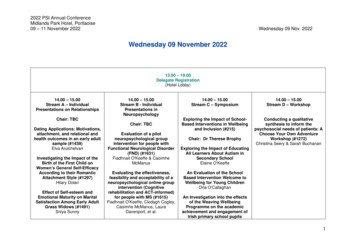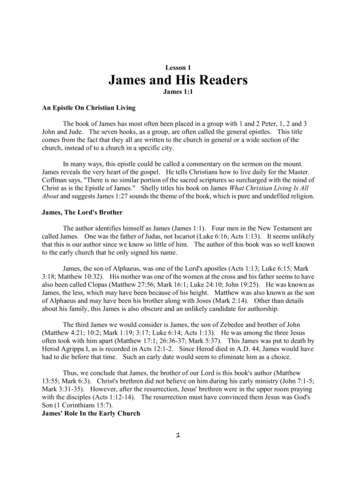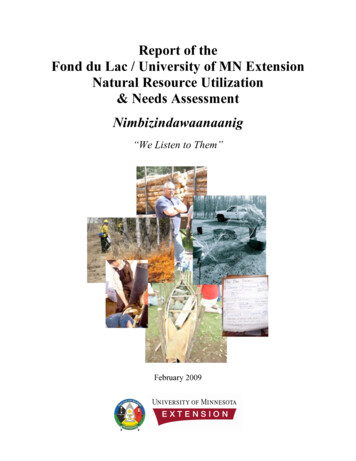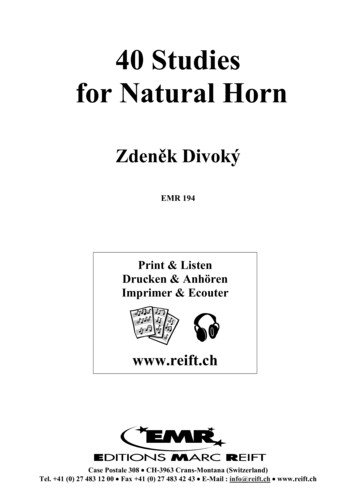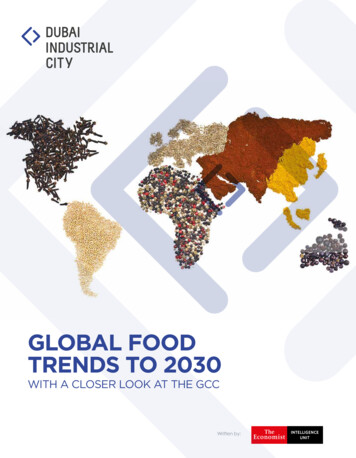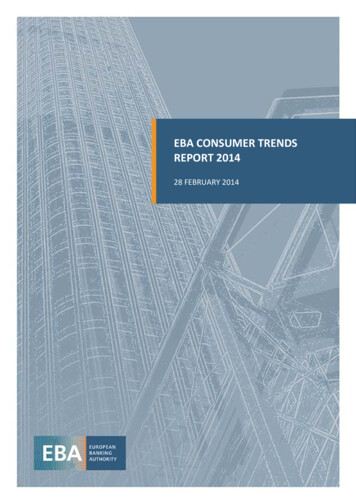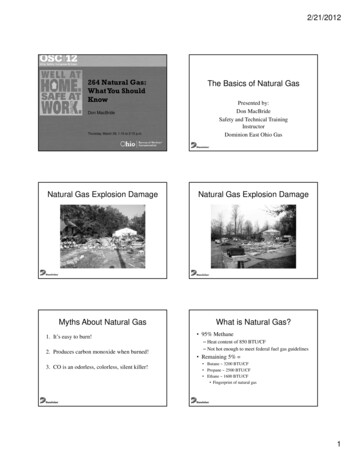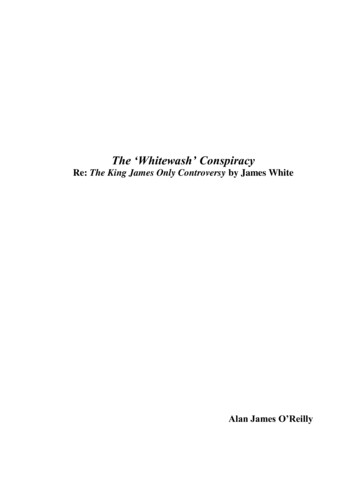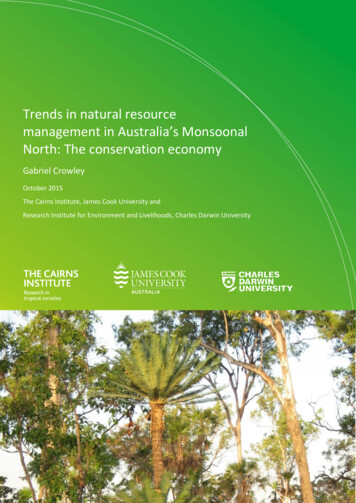
Transcription
Trends in natural resourcemanagement in Australia’s MonsoonalNorth: The conservation economyGabriel CrowleyOctober 2015The Cairns Institute, James Cook University andResearch Institute for Environment and Livelihoods, Charles Darwin University i
Suggested CitationCrowley, G.M. (2015) Trends in natural resource management in Australia’s Monsoonal North: Theconservation economy. Cairns: The Cairns Institute, James Cook University.ISBN 978-0-9944984-1-0This report is licenced under a Creative Commons Attribution 3.0 Australia licence. You are free tocopy, communicate and adapt this work, so long as you attribute James Cook University [The CairnsInstitute] and the author.
ContentsList of tables . iList of figures . iiAcronyms and abbreviations . ivAbout the author . viAcknowledgements and disclaimer . viiExecutive summary . 1Introduction . 3Drivers of the conservation economy . 3Concepts and definitions . 7Ecosystem services. 7The conservation economy . 8Decisions about resource allocation . 9Instruments of the conservation economy. 11Market and policy essentials . 15Prioritisation of conservation investment . 16Biodiversity and cultural heritage . 17Biosecurity surveillance . 31Weed and pest animal control. 32Marine debris . 32Carbon investments . 34Avoided deforestation . 37Tree planting and regrowth . 38Fire management . 40Reducing methane emissions from beef cattle . 41Soil carbon . 42Water . 42Water allocation . 42River system integrity . 42Water quality protection . 44Grazing land stewardship. 45Indigenous economic development. 45Conservation economy opportunities for the Monsoonal North . 47Australian Government funding programs . 50Indigenous Protected Areas . 52Working on Country . 53Indigenous Carbon Farming Fund . 54Indigenous Advancement Strategy . 54National Landcare Programme and Green Army. 55Threatened Species Strategy . 57Great Barrier Reef water quality improvement . 57Western Australia . 58Indigenous engagement . 59Kimberley Science and Conservation Strategy . 59Conservation covenants and Land for Wildlife . 60Community grants. 61Northern Territory . 61Department of Land and Resource Management . 62
Conservation agreements . 63Department of Primary Industries and Fisheries . 64Funding and grant programs. 65Queensland . 66Department of Environment and Heritage Protection . 67Nature Refuges and NatureAssist . 71Department of Agriculture and Fisheries . 73Sustainability loans . 74Environmental offset programs . 75Western Australia . 76Northern Territory . 77Queensland . 77Carbon economy . 78Fire management to abate nitrous oxide and methane . 83Adjusting cattle diets to reduce methane emissions. 85Improving herd genetics and management to reduce methane emissions . 85Tree planting and managed regrowth . 87Sequestering soil carbon . 88Water . 92Non-government organisations . 93Ecotourism . 98Indigenous natural resource management. 99Ranger programs and protected area management . 99Indigenous carbon projects . 101Sustainable use of wildlife . 101Biosecurity surveillance . 102Removal of marine debris . 102Pastoral industry . 103Grazing land stewardship. 104Carbon options. 106Biodiversity conservation. 107Water quality improvement . 108Financial assistance . 110Market access and accreditation . 112Extension and adoption . 114Synthesis and conclusions. 115Drivers and framework . 115Conservation priorities. 116Existing mechanisms and future prospects . 117References . 120
List of tablesTable 1. Key factors shaping the conservation economy . 5Table 2. Capitals making up the conservation economy . 10Table 3. Australian national and state/territory-level conservation prioritisation systems. 20Table 4. Number of beef cattle operations in the Monsoonal North in 2010-11, and their relativeimportance . 42Table 5. Recent funding by current Australian Government programs for natural and cultural resourcemanagement . 51Table 6. Past funding rounds of discontinued Australian Government sources of funding for naturaland cultural resource management. 52Table 7. Funding for the Jobs, Land and Economy Programme of the Indigenous Advancement Strategy. 55Table 8. Strategic objectives to address Australia’s national and international obligations . 56Table 9. Current Western Australia government sources of funding for undertaking cultural andnatural resource management projects . 61Table 10. Elements of the Department of Land and Resource Management Strategic Plan relating tothe conservation economy . 63Table 11. Elements of the Department of Primary Industries and Fisheries Northern Territory IndustryDevelopment Plan relating to the conservation economy . 64Table 12. Current Northern Territory sources of funding for undertaking cultural and natural resourcemanagement projects . 66Table 13. Elements of the Queensland Department of Environment and Heritage Protection strategicplan relating to the conservation economy. 68Table 14. Current and previous Queensland sources of funding for undertaking cultural and naturalresource management projects . 70Table 15. Nature Refuges in the Monsoonal North region . 72Table 16. Elements of the Queensland Department of Agriculture and Fisheries Strategic Plan relatingto the conservation economy . 74Table 17. Estimated income and costs of sample ERF carbon projects on pastoral properties . 81Table 18. Number of approved carbon projects at 18 September 2015 . 82Table 19. Options for reducing methane emissions from northern beef cattle through dietaryadjustment . 85Table 20. Options for reducing methane emissions from northern beef cattle through herdmanagement . 86Table 21. Examples of herd management for reducing methane emissions from northern beef cattle. 86Table 22. Conservation economy activities of non-government organisations in the Monsoonal North. 95Table 23. Assessment of potential emission reduction methods relevant to Indigenous land in theMonsoonal North . 101Table 24. Management to protect and improve grazing land condition, also listing biodiversity benefits. 105Table 25. Specific actions for biodiversity conservation on pastoral properties and impact on livestockproduction . 108Table 26. Priority areas for conservation economy activities in the Monsoonal North . 118i Page
List of figuresFigure 1. Classification of ecosystem services used in the Millennium Ecosystem Assessment and asadapted by other writers . 8Figure 2. Identification of mechanisms to promote environmentally-responsible management inrelation to private-public benefit and duty of care responsibilities . 11Figure 3. Comparison of the benefits three forms of environmental management (a) fencing pastoralland for wildlife conservation (b) improving grass cover for both pastoral productivity andwater quality and (c) restoring fire management by supporting Indigenous ranger groups . 12Figure 4. Market characteristics of the conservation economy . 15Figure 5. Global map of World Heritage properties . 17Figure 6. Australian World Heritage properties. 18Figure 7. Priority areas based on relative abundance of (a) nationally threatened species, (b) nationallythreatened communities in relation to the Monsoonal North regions . 24Figure 8. Priority areas for water quality improvement . 25Figure 9. Prioritisation of Australian landscapes based on naturalness a) bioregional extent of nativevegetation, b) least disturbed river systems, c) number of invasive vertebrate species presentand d) migratory species. 26Figure 10. Australian biodiversity hotspots . 26Figure 11. Priority areas for biodiversity and heritage conservation in the Monsoonal North . 27Figure 12. Projected changes in richness of bird, mammal, reptile and amphibian species, as measuredby habitat suitability . 28Figure 13. Projected loss and gain of bird, mammal, reptile and amphibian species by 2085 asmeasured by habitat suitability . 28Figure 14. Projected stability of habitat suitability . 29Figure 15. Trans-Australia Eco-Link corridor . 29Figure 16. Sources of biosecurity risks for northern Australia. 31Figure 17. Distribution of plastics in Australian and adjacent waters . 33Figure 18. Abundance and distribution of ghost nets from 2004 – 2012 . 34Figure 19. Australian greenhouse gas emissions by sector . 35Figure 20. Historical and projected Australian GHG emissions from land use, land use change andforestry before (a) and after (b) accounting for changes to vegetation management legislation. 35Figure 21. Historical and projected contribution of livestock, cropping and savanna burning toAustralian GHG emissions . 36Figure 22. Estimated above-ground tree carbon stocks in northern Australian savannas. 38Figure 23. Priority areas for reforestation in Queensland based on varying combinations of carbon andbiodiversity values . 39Figure 24. Viability of managing fire to reduce carbon emissions achieving reductions of 25% (red),34% (blue) and 48% (green) under six carbon prices . 40Figure 25. Numbers of beef cattle in Australia in 2011 . 41Figure 26. Map of Australian catchments highlighting the 10 catchments with the highest averageannual runoff . 43Figure 27. Status of Queensland Wild River declarations in June 2010 . 43Figure 28. Land uses in Great Barrier Reef catchments. 44Figure 29. Prioritisation of pollutant management in the Great Barrier Reef Catchments . 45Figure 30. Indigenous estate and discrete Indigenous communities, 2010 . 47Figure 31. Monsoonal North conservation economy opportunities presented on the Lockie matrix . 49Figure 32. Location of Working on Country ranger groups and Indigenous Protected Areas . 53Figure 33. Distribution of (a) National Landcare Programme projects (National stream only), (b) GreenArmy projects and (c) 20 Million Trees service providers in relation to the Monsoonal Northregion . 57ii P a g e
Figure 34. Kimberley Science and Conservation Strategy . 60Figure 35. Allocation of Western Australian Community Grants in the Kimberley, 2010 . 61Figure 36. Queensland Indigenous land and sea management ranger groups . 69Figure 37. Steps involved in establishing and acquitting an ERF project with sale to the Clean EnergyRegulator. 79Figure 38. Options for landholders to participate in the carbon market . 80Figure 39. Savanna burning and fire management projects registered by 18 September 2015 in relationto rainfall zones. 84Figure 40. Soil carbon concentration in relation to perennial grass tussock in good condition land (left)and poor condition land (right). 89Figure 41. Example sampling regime for a Carbon Assessment Area (CAE) showing nine strata, eachwith three sample locations . 90Figure 42. Relationship between the number of composite soil samples and sampling strata and themagnitude of changes in soil organic carbon (SOC) that can be detected . 91Figure 43 Australian Wildlife Conservancy sanctuaries . 96Figure 44 Priority landscapes, reserves and partnerships of Bush Heritage Australia . 97Figure 45. Indigenous ranger groups engaged in ghost net removal . 103Figure 46. Australian beef supply chain . 112Figure 47. Method of sale of northern beef cattle in 2011-12 (b). 113Figure 48. Market suitability of northern Australian cattle grown on different feed regimes . 114iii P a g e
Acronyms and abbreviationsACAPAgreement on the Conservation of Albatrosses and PetrelsACCUAustralian Carbon Credit UnitsAQISAustralian Quarantine Inspection ServiceAWCAustralian Wildlife ConservancyBHABush Heritage AustraliaBMPBest Management PracticesCAECarbon Assessment AreaCAMBAChina-Australia Migratory Bird AgreementCBDConvention on Biological Diversity 1992CERClean Energy RegulatorCLMAConservation and Land Management Act 1984CPALSMPACobourg Peninsula Aboriginal Land, Sanctuary and Marine Park Act (NT)CthCommonwealthDPMCDepartment of the Prime Minister and CabinetEOAEnvironment Offsets Act 2014 (Qld)EPAEnvironmental Protection Act 1994 (Qld)EPBCEnvironment Protection and Biodiversity Conservation Act 1999 (Cth)ERFEmission Reduction FundFullCAMFull Carbon Accounting ModelGHCGreenhouse GasGBRGreat Barrier ReefIASIndigenous Advancement StrategyIPAIndigenous Protected AreaJAMBAJapan-Australia Migratory Bird AgreementLULUCFLand Use, Land-Use Change and Forestryiv P a g e
MBIMarket Based InstrumentsMSAMeat Standards AustraliaNAQSNorthern Australia Quarantine StrategyNCANature Conservation Act 1992 (Qld)NGONon-Government OrganisationNHT2Natural Heritage Trust (second tranche)NLPNational Landcare ProgrammeNNPANitmiluk (Katherine Gorge) National Park Act (NT)NRMNatural Resource ManagementNTNorthern TerritoryNWINational Water InitiativePAPlanning Act (NT)PWCAParks and Wildlife Commission Act (NT)QDAFQueensland Department of Agriculture and FisheriesQEHPQueensland Department of Environment and Heritage ProtectionQRRAQueensland Rural Adjustment AuthorityRamsarRamsar Convention on WetlandsROKAMBARepublic of Korea-Australia Migratory Bird AgreementSOCSoil Organic CarbonTPWCATerritory Parks and Wildlife Conservation Act (NT)UNFCCUnited Nations Framework Convention on Climate Change 1992VMAVegetation Management Act 1999 (Qld)WCAWildlife Conservation Act 1950 (WA)WHCWorld Heritage Convention 1972WOCWorking on CountryWRAWild Rivers Act 2005 (Qld)WWFWorld Wildlife Fundv Page
About the authorGabriel Crowley has over 20 years’ experience assisting natural resource managers meet theirplanning, management and conservation goals.Her interest in natural resource management began on Cape York Peninsula in 1992, when she workedwith pastoralists to reverse the decline of open grassy woodlands that have high conservation andpastoral values to development of fire and grazing management guidelines. She undertook similarcollaborative work with landholders on Kangaroo Island for Glossy Black-Cockatoo conservation.Returning to northern Australia in 1998, she worked in Queensland Parks and Wildlife and the TropicalSavannas Cooperative Research Centre to support sustainable land management through productionof fire and wildlife management guides and web-based tools.She subsequently led the development of: Northern Territory's 2010-2015 Integrated Natural Resource Management Plan Queensland Government’s 10M Reef Policy Science Program to inform best practice canefarming and cattle grazing and prioritise investment in research gaps (2010-2011) Meat and Livestock Australia’s 10-year Research, Development and Engagement Plan toimprove fire management on northern grazing lands (2013) The research plan to inform Natural Resource Management across northern Australia (2014).This report and its companion volume Trends in natural resource management in Australia’sMonsoonal North: The beef industry are a continued expression of her commitment to support theinformation needs landholders and Natural Resource Management groups.Gabriel is an Adjunct Principal Research Fellow with The Cairns Institute, Cairns, Australia.vi P a g e
Acknowledgements and disclaimerThis project was fund in part by the Australian Government’s Regional Natural Resource ManagementPlanning for Climate Change Fund. Supplementary funding was provided by Northern Gulf ResourceManagement Group (NGRMG). My thanks go to Brendan Edgar and Andrew Campbell (Charles DarwinUniversity) for inviting me to undertake this project. I also thank Allan Dale (James Cook University),who provided guidance, support and comments on the text, and Katrina Keith (James Cook Uni
Suggested Citation Crowley, G.M. (2015) Trends in natural resource management in Australia's Donsoonal Eorth: The conservation economy.Cairns: The Cairns Institute, James Cook University. ISBN 978-0-9944984-1-0 This report is licenced under a Creative Commons Attribution 3.0 Australia licence.

